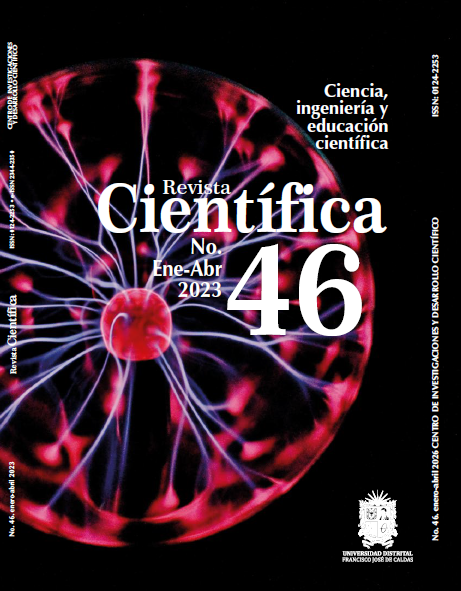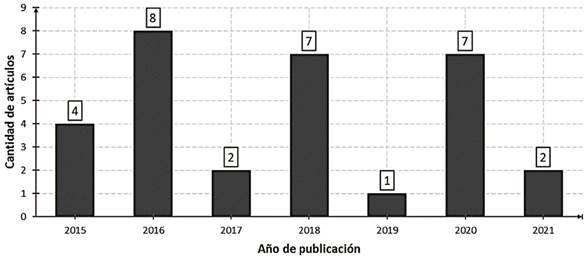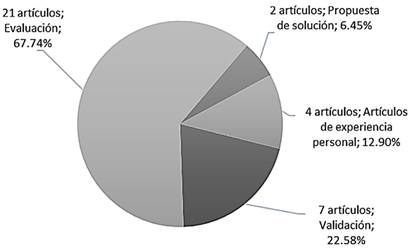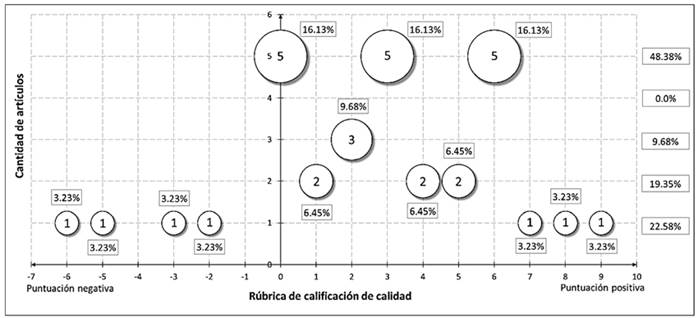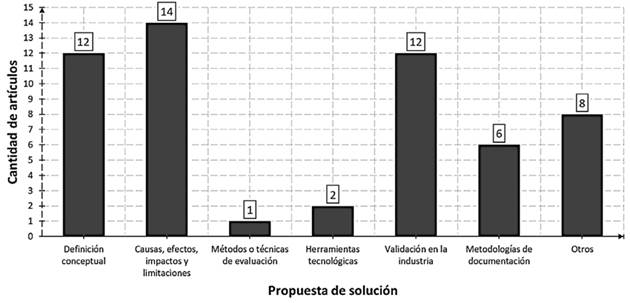DOI:
https://doi.org/10.14483/23448350.19670Published:
01/02/2023Issue:
Vol. 46 No. 1 (2023): January-April 2023Section:
Ingeniería y TecnologíaDeuda de la documentación en el desarrollo ágil de software: mapeo sistemático de la literatura
Documentation Debt in Agile Software Development: A Systematic Mapping of the Literature
Keywords:
Agile software development, documentation debt, technical debt, software documentation, documentation debt management (en).Keywords:
Desarrollo ágil de software, deuda de la documentación, deuda técnica, documentación de software, gestión de la deuda de la documentación (es).Downloads
References
Aghajani, E., Nagy, C., Vega-Márquez, O. L., Linares-Vásquez, M., Moreno, L., Bavota, G., Lanza, M. (2019). Software documentation issues unveiled. En IEEE/ACM 41st International Conference on Software Engineering (ICSE), 1199-1210. https://doi.org/10.1109/ICSE.2019.00122 DOI: https://doi.org/10.1109/ICSE.2019.00122
Alsaqqa, S., Sawalha, S., Abdel-Nabi, H. (2020). Agile software development: Methodologies and trends. International Journal of Interactive Mobile Technologies, 14(11), 246-270. https://doi.org/10.3991/ijim.v14i11.13269 DOI: https://doi.org/10.3991/ijim.v14i11.13269
Alves, N., Mendes, T., de Mendonça, M., Spinola, R., Shull, F., Seaman, C. (2016). Identification and management of technical debt: A systematic mapping study. Information and Software Technology, 70, 100-121. https://doi.org/10.1016/j.infsof.2015.10.008 DOI: https://doi.org/10.1016/j.infsof.2015.10.008
Basili, V. R., Caldiera, G. (1994). Goal Question Metric Paradigm. Encyclopedia of Software Engineering - 2 Volume Set, 528-532. https://www.cs.umd.edu/~basili/publications/technical/T89.pdf
Behutiye, W. N., Rodríguez, P., Oivo, M., Tosun, A. (2017). Analyzing the concept of technical debt in the context of agile software development: A systematic literature review. Information and Software Technology, 82, 139-158. https://doi.org/10.1016/j.infsof.2016.10.004 DOI: https://doi.org/10.1016/j.infsof.2016.10.004
Budgen, D., Turner, M., Brereton, P., Kitchenham, B. (2008). Using Mapping Studies in Software Engineering. En Proceedings of the 20th Annual Workshop of the Psychology of Programming Interest Group.
Cappelli, C., Engiel, P., Araujo, R. de, do Prado Leite, J. (2013). Managing transparency guided by a maturity model. En 3rd Global Conference on Transparency Research HEC.
Charalampidou, S., Ampatzoglou, A., Chatzigeorgiou, A., Tsiridis, N. (2018). Integrating traceability within the IDE to prevent requirements documentation debt. En 44th Euromicro Conference on Software Engineering and Advanced Applications (SEAA), 421-428. https://doi.org/10.1109/SEAA.2018.00075 DOI: https://doi.org/10.1109/SEAA.2018.00075
CORE Inc. (s.f.). CORE Conference Ranks. http://portal.core.edu.au/conf-ranks/
Hazzan, O., Dubinsky, Y. (2014). The agile manifesto. In: Agile Anywhere: Essays on Agile Projects and Beyond (pp. 9-14). Springer. https://doi.org/10.1007/978-3-319-10157-6_3 DOI: https://doi.org/10.1007/978-3-319-10157-6_3
Islam, Z., Ferworn, A. (2020). A Comparison between agile and traditional software development methodologies. Global Journal of Computer Science and Technology, 20(2), 7-42. https://doi.org/10.34257/gjcstcvol20is2pg7 DOI: https://doi.org/10.34257/GJCSTCVOL20IS2PG7
Jalali, S., Wohlin, C. (2012). Systematic literature studies: Database searches vs. backward snowballing. En ESEM ’12: Proceedings of the ACM-IEEE International Symposium on Empirical Software Engineering and Measurement, 29-38. https://doi.org/10.1145/2372251.2372257 DOI: https://doi.org/10.1145/2372251.2372257
Kamal, T., Zhang, Q., Akbar, M. A., Shafiq, M., Gumaei, A., Alsanad, A. (2020). Identification and prioritization of agile requirements change management success factors in the domain of global software development. IEEE Access, 8, 44714-44726. https://doi.org/10.1109/ACCESS.2020.2976723 DOI: https://doi.org/10.1109/ACCESS.2020.2976723
Kitchenham, B., Charters, S. (2007). Guidelines for performing Systematic Literature Reviews in Software Engineering, Version 2.3. EBSE Technical Report, Keele University, & University of Durham, UK
Li, Z., Avgeriou, P., Liang, P. (2015). A systematic mapping study on technical debt and its management. Journal of Systems and Software, 101, 193-220. https://doi.org/10.1016/j.jss.2014.12.027 DOI: https://doi.org/10.1016/j.jss.2014.12.027
Martini, A., Besker, T., Bosch, J. (2020). Process debt: A first exploration. En 27th Asia-Pacific Software Engineering Conference (APSEC), 316-325. https://doi.org/10.1109/APSEC51365.2020.00040 DOI: https://doi.org/10.1109/APSEC51365.2020.00040
Martini, A., Stray, V., Moe, N. B. (2019). Technical-, social- and process debt in large-scale agile: An exploratory case-study. In: R. Hoda (Ed.), Agile Processes in Software Engineering and Extreme Programming - Workshops (pp. 112-119). Springer. https://doi.org/10.1007/978-3-030-30126-2_14 DOI: https://doi.org/10.1007/978-3-030-30126-2_14
Matturro, G., Raschetti, F., Fontán, C. (2019). A systematic mapping study on soft skills in software engineering. Journal of Universal Computer Science, 25(1), 16-41. https://doi.org/10.3217/jucs-025-01-0016
McBurney, P. W., Jiang, S., Kessentini, M., Kraft, N. A., Armaly, A., Mkaouer, M. W., McMillan, C. (2018). Towards prioritizing documentation effort. IEEE Transactions on Software Engineering, 44(9), 897-913. https://doi.org/10.1109/TSE.2017.2716950 DOI: https://doi.org/10.1109/TSE.2017.2716950
Petersen, K., Feldt, R., Mujtaba, S., Mattsson, M. (2008). Systematic mapping studies in software engineering. En EASE’08: Proceedings of the 12th international conference on Evaluation and Assessment in Software Engineering, 68-77 DOI: https://doi.org/10.14236/ewic/EASE2008.8
Petersen, K., Vakkalanka, S., Kuzniarz, L. (2015). Guidelines for conducting systematic mapping studies in software engineering: An update. Information and Software Technology, 64, 1-18. https://doi.org/10.1016/j.infsof.2015.03.007 DOI: https://doi.org/10.1016/j.infsof.2015.03.007
Portela, L. T., Borrego, G. (2016). Scrumconix: Agile and documented method to AGSD. En IEEE 11th International Conference on Global Software Engineering (ICGSE), 195-196. https://doi.org/10.1109/ICGSE.2016.39 DOI: https://doi.org/10.1109/ICGSE.2016.39
Rios, N., Mendes, L., Cerdeiral, C., Magalhães, A. P. F., Perez, B., Correal, D., Astudillo, H., Seaman, C., Izurieta, C., Santos, G., Oliveira Spínola, R. (2020a). Hearing the voice of software practitioners on causes, effects, and practices to deal with documentation debt. In: N. Madhavji, L. Pasquale, A. Ferrari, S. Gnesi (Eds.), Requirements Engineering: Foundation for Software Quality (pp. 55-70). Springer. https://doi.org/10.1007/978-3-030-44429-7_4 DOI: https://doi.org/10.1007/978-3-030-44429-7_4
Rios, N., Spínola, R. O., Mendonça, M., Seaman, C. (2020b). The practitioners’ point of view on the concept of technical debt and its causes and consequences: a design for a global family of industrial surveys and its first results from Brazil. Empirical Software Engineering, 25(5), 3216-3287. https://doi.org/10.1007/s10664-020-09832-9 DOI: https://doi.org/10.1007/s10664-020-09832-9
SCImago. (s.f.). SJR - SCImago Journal & Country Rank. https://www.scimagojr.com/
Shafiq, M., Waheed, U. (2018). Documentation in agile development: A comparative analysis. En IEEE 21st International Multi-Topic Conference (INMIC), 1-8. https://doi.org/10.1109/INMIC.2018.8595625 DOI: https://doi.org/10.1109/INMIC.2018.8595625
Shaydulin, R., Sybrandt, J. (2017). To agile, or not to agile: A comparison of software development methodologies. arXiv:1704.07469v1. https://doi.org/10.48550/arXiv.1704.07469
Shmerlin, Y., Hadar, I., Kliger, D., Makabee, H. (2015). To document or not to document? An exploratory study on developers’ motivation to document code. In: A. Persson, J. Stirna (Eds.), Advanced Information Systems Engineering Workshops (pp. 100-106). Springer. https://doi.org/10.1007/978-3-319-19243-7_10 DOI: https://doi.org/10.1007/978-3-319-19243-7_10
Shylesh, S. (2017). A study of software development life cycle process models. SSRN. https://doi.org/10.2139/ssrn.2988291 DOI: https://doi.org/10.2139/ssrn.2988291
Sinha, R., Shameem, M., Kumar, C. (2020). SWOT: Strength, weaknesses, opportunities, and threats for scaling agile methods in global software development. En ISEC 2020: Proceedings of the 13th Innovations in Software Engineering Conference on Formerly known as India Software Engineering Conference. https://doi.org/10.1145/3385032.3385037 DOI: https://doi.org/10.1145/3385032.3385037
State of Agile. (2021). State of Agile Report. https://stateofagile.com/#ufh-c-7027494-state-of-agile
Voigt, S., von Garrel, J., Müller, J., Wirth, D. (2016). A study of documentation in agile software projects. En ESEM’16: Proceedings of the 10th ACM/IEEE International Symposium on Empirical Software Engineering and Measurement, 1-6. https://doi.org/10.1145/2961111.2962616 DOI: https://doi.org/10.1145/2961111.2962616
Wieringa, R., Maiden, N., Mead, N., Rolland, C. (2006). Requirements engineering paper classification and evaluation criteria: A proposal and a discussion. Requirements Engineering, 11(1), 102-107. https://doi.org/10.1007/s00766-005-0021-6 DOI: https://doi.org/10.1007/s00766-005-0021-6
How to Cite
APA
ACM
ACS
ABNT
Chicago
Harvard
IEEE
MLA
Turabian
Vancouver
Download Citation
Recibido: de julio de 2022; Aceptado: de octubre de 2022
Resumen
En el desarrollo de software, la documentación es un proceso continuo en el cual se especifica qué hace el sistema, cómo lo hace y para quién lo hace, describiendo todas sus características desde diferentes perspectivas para facilitar la comprensión de todos los interesados. Sin embargo, esto no siempre se logra, debido a malas prácticas de documentación, lo cual lleva a un tipo de deuda técnica conocida como deuda de la documentación, relacionada con documentación faltante, inconsistente o incompleta que degrada la comprensión del sistema, afectando gravemente su desarrollo, mantenimiento y evolución. Este fenómeno parece agravarse en los enfoques ágiles, ya sea por una mala interpretación de los valores y principios ágiles, enfocándose en la entrega continua de software funcional más que en la documentación exhaustiva, o por desconocimiento de buenas prácticas de documentación. Si bien existen iniciativas que describen de forma general las causas, efectos y buenas prácticas para mitigar la deuda de documentación, aún hace falta comprender el impacto de este tipo de deuda para la industria de software y profundizar en una definición más completa en el desarrollo ágil de software. En ese sentido, se presentan los resultados de un mapeo sistemático que brinda una base sólida de conocimiento sobre la deuda de la documentación en el desarrollo ágil de software y permite identificar brechas u oportunidades de investigación en este tema.
Palabras clave:
desarrollo ágil de software, deuda de la documentación, deuda técnica, documentación de software, gestión de la deuda de la documentación..Abstract
In software development, documentation is a continuous process that specifies what the system does, how it does it, and for whom it does it, describing all its characteristics from different perspectives in order to facilitate the understanding of all the interested parties. However, this is not always achieved due to poor documentation practices, leading to a type of technical debt known as documentation debt, which is related to missing, inconsistent, or incomplete documentation that degrades the understanding of the system, severely affecting its development, maintenance, and evolution. This phenomenon seems to be aggravated in agile approaches, either due to a misunderstanding of agile values and principles by focusing on the continuous delivery of functional software rather than comprehensive documentation, or a lack of good documentation practices. Although there are initiatives that generally describe the causes, effects, and good practices to mitigate documentation debt, it is still necessary to understand the impact of this type of debt on the software industry and to delve into a more complete definition in agile software development. In this sense, the results of a systematic mapping are presented, which provide a solid base of knowledge about documentation debt in agile software development and allow identifying gaps or research opportunities in this topic.
Keywords:
agile software development, documentation debt, documentation debt management, software documentation, technical debt..Resumo
No desenvolvimento de software, a documentação é um processo contínuo em que se especifica o que o sistema faz, como faz e para quem faz, descrevendo todas as suas características sob diferentes perspectivas para facilitar o entendimento de todos os interessados. No entanto, isso nem sempre é alcançado devido às más práticas de documentação, levando a um tipo de dívida técnica conhecida como dívida de documentação relacionada à documentação ausente, inconsistente ou incompleta que degrada a compreensão do sistema, afetando severamente seu desenvolvimento, manutenção e evolução. Esse fenômeno parece ser agravado nas abordagens ágeis, seja por uma incompreensão dos valores e princípios ágeis, com foco na entrega contínua de software funcional em vez de documentação abrangente, ou pela falta de boas práticas de documentação. Embora existam iniciativas que geralmente descrevem as causas, efeitos e boas práticas para mitigar a dívida de documentação, ainda é necessário entender o impacto desse tipo de dívida para a indústria de software e aprofundar uma definição mais completa em desenvolvimento ágil. . Nesse sentido, são apresentados os resultados de um mapeamento sistemático que fornece uma base sólida de conhecimento sobre a dívida de documentação no desenvolvimento ágil de software e permite identificar lacunas ou oportunidades de pesquisa neste tema.
Palavras-chaves:
desenvolvimento ágil de software, dívida de documentação, dívida técnica, documentação de software, gestão de dívida de documentação..Introducción
Actualmente, las empresas de software dedican grandes esfuerzos en la definición de buenas prácticas, procesos y técnicas que permitan mejorar las actividades ejecutadas durante el ciclo de vida de sus proyectos. En particular, la documentación del sistema es una de las más críticas ya que: (i) estandariza el conocimiento presente en los proyectos, (ii) alinea los objetivos estratégicos de la organización con los deseos del cliente, (iii) facilita que los equipos tengan una comprensión holística del sistema (Aghajani et al., 2019; Matturro et al., 2019), y (iv) establece una dirección clara hacia la transparencia con los clientes, lo que permite la implementación de soluciones acordes con sus necesidades (Shmerlin et al., 2015).
En este sentido, la falta de documentación consistente y eficaz que permita describir de manera clara y unívoca las características de un sistema se ha convertido en una problemática de alto impacto para la industria del software en general (Rios et al., 2020b). Las consecuencias de esta problemática están relacionadas con: (i) falta de conocimiento estandarizado en los proyectos, (ii) degradación de la integridad del sistema en el tiempo, (iii) dificultad para mantener una trazabilidad de nuevos cambios en etapas futuras del proyecto y (iv) poca claridad de los deseos del cliente (McBurney et al., 2018).
Además, se desconocen estándares y modelos de facto para documentar el proyecto en todas sus fases, lo que incrementa la incidencia de malas prácticas relacionadas con la definición, implementación, seguimiento y entrega de los artefactos de documentación necesarios para el proyecto (McBurney et al., 2018).
Con el objetivo de establecer estrategias que permitan estructurar de manera clara las actividades presentes durante el ciclo de vida de los proyectos existen enfoques tradicionales y ágiles que caracterizan las fases del ciclo de vida del software. Cada uno presenta ventajas y desventajas de acuerdo con las necesidades de documentación de la organización (Shylesh, 2017); por ejemplo: los enfoques tradicionales son rigurosos y recomiendan comenzar con el desarrollo del sistema solo después de haber documentado de forma exhaustiva las decisiones de diseño funcional y no funcional, lo cual establece un panorama claro desde etapas iniciales del proyecto, pero reduce la flexibilidad en etapas posteriores debido a que los cambios no contemplados que ocurran en el futuro no son bien recibidos (Shaydulin y Sybrandt, 2017; Islam y Ferworn, 2020).
Por otra parte, los enfoques ágiles proponen el principio “software funcional sobre documentación exhaustiva” (Hazzan y Dubinsky, 2014), priorizando la entrega de valor continuo en periodos cortos de tiempo (Alsaqqa et al., 2020), no obstante, esto puede llevar a malas interpretaciones u omisiones y, como consecuencia, generar procesos subóptimos, inmaduros, poco claros y que son aplicados de manera incorrecta por los equipos (Martini et al., 2020). Adicionalmente, la interpretación subjetiva de los principios ágiles puede llevar a malas prácticas para entregar prematuramente el sistema, resultando en una acumulación progresiva de deuda técnica que degrada el software con el paso del tiempo y que genera reprocesos, aumenta las brechas de mantenibilidad del sistema y baja la productividad de los equipos de trabajo (Rios et al., 2020a).
Actualmente, los enfoques ágiles son muy utilizados en la industria de software y han apoyado procesos como: pruebas, gestión de proyectos, técnicas de programación o mantenimiento (State of Agile, 2021). No obstante, enfrentan desafíos para lograr que la documentación sea más comprensible, concreta, precisa y clara para todos los interesados sin descuidar la entrega de valor continuo (Rios et al., 2020a) y garantizando una mayor transparencia de los artefactos de documentación (Shafiq y Waheed, 2018; Voigt et al., 2016). Los procesos de negocio en las empresas deben documentarse para que sean fácilmente accesibles, usables, informativos, entendibles y auditables (Cappelli et al., 2013), y así podrían ser más claros, coherentes, consistentes y evolucionarían correctamente (Martini et al., 2020).
Ahora bien, la documentación es una de las actividades que menos interés despierta en los equipos (Rios et al., 2020a), siendo evitada aproximadamente en el 60 % de los casos (Rios et al., 2020b). Esto se debe principalmente a: (i) genera poco interés en los equipos porque puede tomar mucho tiempo, y (ii) la tendencia de los profesionales a pensar que otras actividades como el diseño, la implementación, pruebas o la arquitectura ofrecen un valor más visible para los interesados (Rios et al., 2020a) dejando de lado la documentación. Por esto, además de la ejecución de procesos incompletos, ambiguos y poco claros, surge un fenómeno bastante nocivo para el software conocido como deuda de la documentación (en adelante DD), lo que a su vez conduce a otros tipos de deudas como: deuda de procesos (Martini et al., 2019), deuda técnica relacionada con aspectos operativos (Behutiye et al., 2017) y deuda social relacionada con la interacción entre los miembros del equipo.
En general, una deuda es una obligación adquirida de manera voluntaria para obtener un beneficio a corto o mediano plazo, pero que debe pagarse en un tiempo determinado cumpliendo con los intereses que genera (Rios et al., 2020a; Hazzan y Dubinsky, 2014). En el contexto de la Ingeniería de Software, la deuda se relaciona con aquellas tareas o responsabilidades que no fueron realizadas durante el ciclo de vida o que fueron deficientes, generando intereses como: dilatación de las entregas, disminución de la productividad, baja calidad o insatisfacción del cliente y que deben pagarse a través de reprocesos, sobrecostos, sobrecarga de trabajo (Rios et al., 2020a), por ejemplo, el uso de malas prácticas de codificación puede llevar a futuras refactorizaciones y solución frecuente de incidentes que podrían ser evitados desde el principio mediante el uso de buenas prácticas de codificación, principios y patrones de diseño documentados correctamente (Li et al., 2015; Alves et al., 2016).
Por lo mencionado, y con el propósito de conocer el estado actual del conocimiento sobre deuda de la documentación y su impacto en el desarrollo ágil de software, se presentan los resultados de un mapeo sistemático de la literatura (en adelante MSL) que permitió recopilar información relevante sobre definiciones, validaciones, procesos, propuestas, estudios aplicados y métodos de investigación descritos en la literatura. Se evidencia una ambigüedad en la comprensión de la DD, en especial en el desarrollo ágil de software, debido a que es un tema poco explorado, imposibilitando abordar otras alternativas, como cuantificar el nivel de deuda en la documentación. Asimismo, fue posible encontrar aportes relacionados con la definición conceptual de la DD en el contexto de los enfoques tradicionales y ágiles, causas, efectos y estrategias para mitigarla o prevenirla aplicando buenas prácticas y herramientas tecnológicas que automatizan el proceso de documentación. Sin embargo, no se evidenciaron estudios que busquen medir, cuantificar o caracterizar la DD.
Finalmente, el resto del documento está organizado así: en la segunda sección se presenta la metodología de búsqueda. En la tercera sección se presenta el análisis de los resultados obtenidos en la búsqueda. Y en la cuarta sección se presentan las conclusiones y trabajos futuros.
Metodología
El MSL presentado sigue los lineamientos de Petersen et al. (2015); Kitchenham y Charters (2007) y Budgen et al. (2008), para las actividades: (i) definición de las preguntas de investigación; (ii) conducción de la búsqueda de artículos relevantes; (iii) selección de artículos primarios aplicando criterios de inclusión y exclusión; (iv) evaluación de la calidad de los artículos primarios; y (v) extracción de información. En la Figura 1 se presenta proceso, actividades, entradas y salidas obtenidas en la búsqueda.
Figura 1: Proceso para el mapeo sistemático sugerido por Petersen et al. (2008).
Definición de las preguntas de investigación
Se definieron seis preguntas de investigación mediante el enfoque Goal-Question-Metric (GQM) (Basili y Caldiera, 1994), sin embargo, solo se consideraron el nivel conceptual, para establecer los objetivos de la revisión y el nivel operativo, para definir las preguntas que darán cumplimiento a los objetivos. A continuación, se presentan los objetivos de búsqueda (en adelante OB) definidos en el primer nivel:
-
OB1. Categorizar las evidencias para dimensionar el interés científico e investigativo de la DD durante el desarrollo ágil de software.
-
OB2. Conocer las principales iniciativas científicas sobre DD en el desarrollo ágil de software y clasificarlas según el esquema propuesto por Wieringa et al. (2006) y la definición de criterios de calidad para establecer su relevancia.
-
OB3. Recopilar información sobre definiciones conceptuales, propuestas, validaciones, procesos y métodos de investigación para identificar el grado de desarrollo de las iniciativas.
En la Tabla 1 se presentan las preguntas de investigación y el OB asociado para categorizar la información relevante sobre la DD en el desarrollo ágil de software.
Tabla 1: Preguntas de investigación.
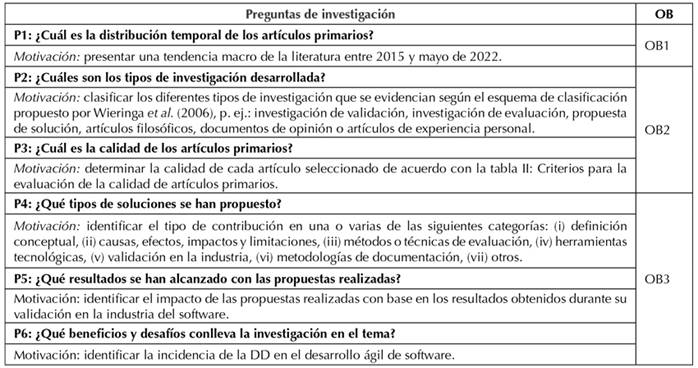
Búsqueda de artículos relevantes
El proceso fue llevado a cabo mediante la siguiente cadena de búsqueda: “documentation debt” OR “process debt” AND (“agile software projects” OR “agile software development” OR “agile development” OR “agile approach”), la cual fue adaptada y ejecutada en siete bases de datos científicas: IEEE Xplore, Science Direct, Scopus, Google Scholar, Springer Link, ACM y Web Of Science. Se consideró una ventana de tiempo entre 2015 y mayo de 2022. La búsqueda se inició en 2015 debido a que fue el año cuando se evidencian los primeros trabajos enfocados en DD.
Criterios de inclusión y exclusión
La selección de artículos relevantes se basó en una revisión de tres niveles: (nivel 1) revisión del título, (nivel 2) revisión del resumen o abstract, introducción y conclusiones, y (nivel 3) revisión sobre el texto completo para determinar si el artículo cumplía con al menos uno de los siguientes criterios de inclusión (CI):
-
CI1. Artículos cuyo tema principal sea la DD en el desarrollo ágil de software.
-
CI2. Artículos cuyo tema se relacione con la documentación de software.
-
CI3. Artículos que traten temas relacionados con la deuda técnica.
-
CI4. Artículos que hayan sido publicados en revistas, congresos o conferencias de prestigio con revisión por pares.
Posteriormente, para la selección de artículos primarios, se descartaron aquellos artículos que cumplieran con al menos uno de los siguientes criterios de exclusión (CE):
-
CE1. Artículos duplicados (considerando solo el más completo y reciente).
-
CE2. Artículos donde se aborde superficialmente el tema de investigación.
-
CE3. Artículos donde no se aborden problemas relacionados con la deuda de la documentación de software durante el desarrollo ágil de software.
-
CE4. Artículos de tipo debate o disponibles solo en forma de presentaciones o resumen.
Criterios de evaluación de la calidad
Con el propósito de medir la calidad de los artículos primarios y determinar su grado de pertinencia con respecto a la DD en el desarrollo ágil de software, se diseñó un método de evaluación basado en doce criterios con una puntuación de tres valores: no cumple (-1), cumple parcialmente (0) y sí cumple (+1) (Kitchenham y Charters, 2007). Así cada artículo puede obtener una calificación entre -12 y +12. No obstante, el objetivo de evaluar la calidad de los estudios es identificar aquellos que son más pertinentes para la investigación, por lo que una puntuación baja no es un criterio de exclusión. Los criterios de evaluación de la calidad se presentan en la Tabla 2.
Tabla 2: Criterios de evaluación de la calidad.
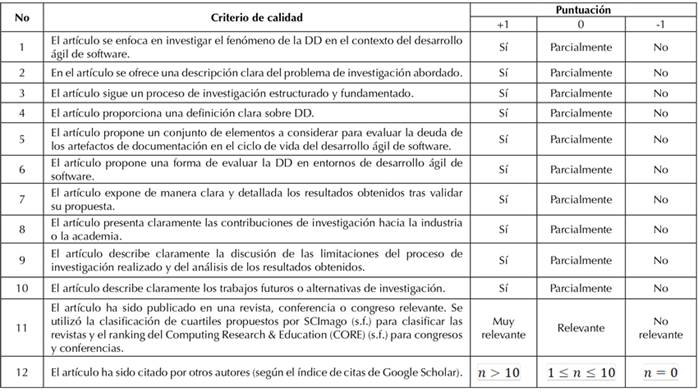
Estrategia de extracción de datos
Para realizar una extracción uniforme de la información relevante de los estudios primarios, se definió una ficha con los elementos necesarios para el análisis de los artículos. En la Tabla 3 se presenta la ficha definida para apoyar la estrategia de extracción de datos. Además, esta plantilla facilitó el proceso de análisis en etapas posteriores.
Tabla 3: Ficha de información relevante.
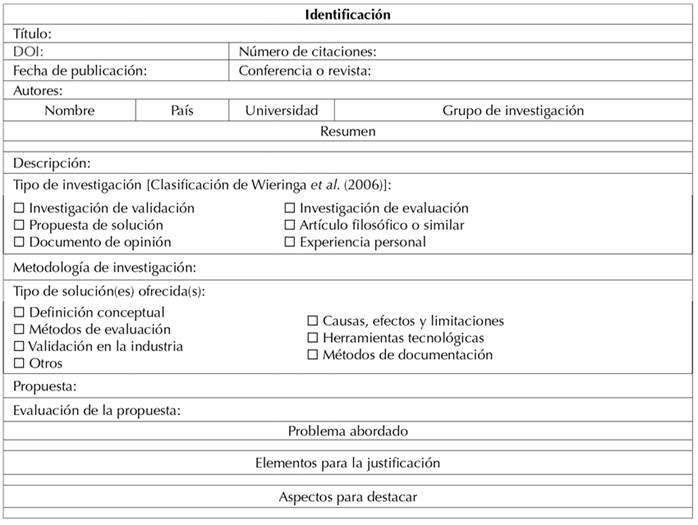
Ejecución de la búsqueda
Se realizó una iteración por cada base de datos: Google Scholar, Scopus, Science Direct, Springer Link, IEEE Xplore, ACM y Web Of Science. Sin embargo, cada motor de búsqueda cuenta con su propia parametrización, por lo cual fue necesario adaptar la cadena de búsqueda de acuerdo con estas configuraciones. En la Tabla 4 se presenta la cadena adaptada a cada base de datos.
Tabla 4: Adaptación de la cadena de búsqueda.
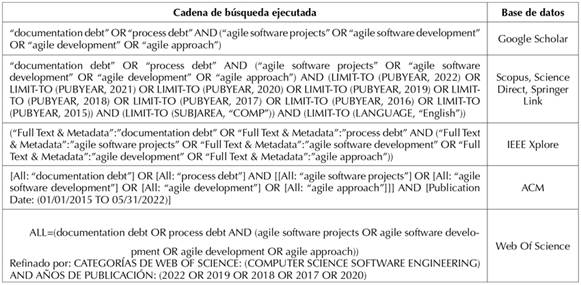
En la Tabla 5 se presenta el resumen de los artículos encontrados. Tras aplicar la cadena de búsqueda, se encontraron 366 artículos; posteriormente, se aplicaron los criterios de inclusión, lo cual redujo el número total a 155 artículos considerados relevantes; finalmente, se aplicaron los criterios de exclusión, de donde resultaron 27 artículos primarios (en adelante AP). Adicionalmente, se aplicó un proceso de revisión hacia atrás (backward snowballing) (Jalali y Wohlin, 2012) a los AP con el propósito de identificar estudios que fueron omitidos en los resultados de la búsqueda inicial, como resultado, se identificaron cuatro estudios adicionales que fueron clasificados como AP. Y se incluyeron ocho estudios más como literatura gris. El detalle de los artículos primarios puede ser consultado en el siguiente enlace: https://bit.ly/3WAM4NT.
Acrónimos: E: encontrados, R: relevantes, Re: repetidos, P: primarios
Tabla 5: Resultados de la búsqueda
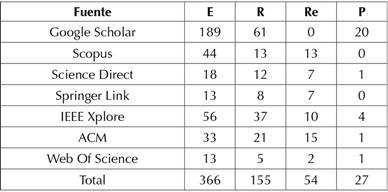
Resultados
A continuación, se presenta el análisis de las respuestas a cada una de las preguntas de investigación. El análisis del aporte de cada artículo a las preguntas planteadas se presenta en el siguiente enlace: https://bit.ly/3YZYuRh.
P1: ¿Cuál es la distribución temporal de los artículos primarios?
De acuerdo con los resultados presentados en la Figura 2, se puede observar que la producción científica en el año 2015 fue del 12,9 % (A2, A10, A25, A28), en 2016 del 29 % (A4, A9, A11, A12, A24, A27, A29, A31), en 2017 del 6,45 % (A5, A15), en 2018 del 22,58 % (A3, A6, A7, A18, A23, A26, A30), en 2019 del 3,22 % (A14), en 2020 del 22,58 % (A1, A8, A13, A16, A17, A21, A22) y en el 2021 del 6,45 % (A19, A20).
Figura 2: Cantidad de artículos por año.
En particular, se observó que en el 51,61 % de los AP se investiga la deuda de la documentación y su relación con la deuda técnica generada en requisitos, diseño, arquitectura, pruebas y despliegue; el 22,58 % de los estudios menciona aspectos de la documentación en el contexto del desarrollo de software, pero no describe su aplicación a través del uso de enfoques tradicionales o ágiles; finalmente, en el 12,9 % restante se proponen soluciones para gestionar la DD en entornos de trabajo que aplican enfoques ágiles.
P2: ¿Cuáles son los tipos de investigación desarrollada?
Según las características de la investigación desarrollada en los AP se realizó una clasificación basada en seis categorías: validaciones, evaluaciones, propuestas de solución, artículos filosóficos, artículos de opinión y artículos de experiencia personal (Wieringa et al., 2006). De acuerdo con esto, los resultados obtenidos son los siguientes: 21 artículos (67,74 %) ejecutan métodos de evaluación a través de estudios de campo, estudios de caso, encuestas o combinaciones de ellos; 7 artículos (22,58 %) realizan procesos de validación a través de mecanismos como revisiones de la literatura y experimentos; 4 artículos (12,90 %) describen la experiencia personal presentada por los autores luego de realizar procesos de investigación en empresas de software; 2 artículos (6,45 %) realizan propuestas de solución en las cuales se proponen ontologías y definiciones conceptuales enfocadas en la documentación de software y su relación con la deuda técnica. Finalmente, no se identificaron estudios de tipo filosófico o de opinión. Lo mencionado se muestra en la Figura 3, pero los detalles de la clasificación de los artículos pueden ser consultados en el siguiente enlace: https://bit.ly/3Z5tmzV.
Figura 3: Distribución porcentual y cantidad de artículos por tipo de investigación.
P3: ¿Cuál es la calidad de los artículos primarios?
La Figura 4 presenta la agrupación de artículos según la calificación obtenida tras la suma de los valores individuales propuestos para llevar a cabo la evaluación de la calidad de los estudios. De acuerdo con los resultados, se puede observar que: el 6,45 % de los artículos (A11, A4) lograron la calificación más alta con 9 y 8 puntos respectivamente, el 3,23 % (A28) con 7 puntos, el 16,13 % (A1, A2, A20, A21, A27) con 6 puntos, el 6,45 % (A24, A25) con 5 puntos, el 6,45 % (A23, A29) con cuatro puntos, el 16,13 % (A3, A14, A17, A22, A26) con 3 puntos, el 9,68 % (A8, A12, A30) con 2 puntos, el 6,45 % (A13, A18) con 1 punto, el 16,13 % (A5, A10, A15, A16, A31) con 0 puntos y el 3,23 % (A19, A7, A9, A6) con -2, -3, -5 y -6 puntos respectivamente.
Los detalles de la clasificación obtenida por los artículos primarios pueden ser consultados en el siguiente enlace: https://bit.ly/3PPxQpN.
Figura 4: Agrupación de artículos según su puntuación de calidad.
P4: ¿Qué tipos de soluciones se han propuesto?
De acuerdo con los resultados presentados en la Figura 5, fue posible observar que el 38,71 % de los estudios (A1, A2, A3, A4, A6, A10, A16, A19, A20, A28, A29, A31) proponen definiciones conceptuales que buscan comprender, estructurar y estandarizar el conocimiento en torno a la DD en el desarrollo ágil de software. Por otro lado, el 45,16 % de los estudios (A1, A2, A3, A5, A7, A8, A9, A10, A12, A15, A17, A18, A20, A23) se enfoca en identificar causas, efectos, limitaciones e impactos que resultan como consecuencia de la DD en el desarrollo ágil de software, por ejemplo: en A1 y A17 se identifican 23 causas que contribuyen a la DD en el desarrollo ágil de software. De esta manera se han identificado un total de 45 causas que contribuyen a la DD y 42 efectos derivados como: código incorrecto, baja calidad del software, retraso en la entrega, entre otros. El detalle de las causas y efectos puede consultarse en https://bit.ly/3WBY5mz y https://bit.ly/3WZGYdU, respectivamente; por otro lado, en A4 y A12 se presentan los resultados después de analizar el impacto de la DD en los proyectos software en términos de costo, tiempo, productividad y degradación del sistema.
Figura 5: Distribución de estudios por tipo de solución.
Con relación a la definición de procesos, técnicas, métodos y soluciones, se identificó que: 1 estudio (3,23 %) (A7) presenta un conjunto de métricas para medir la DD, sin embargo, no se presenta el detalle de las métricas. Por otro lado; 2 estudios (6,45 %) (A3, A7) proponen herramientas para la prevención de la DD durante la etapa de especificación de requisitos ágiles y para permitir la visualización y accesibilidad de la documentación en los proyectos, respectivamente; 12 estudios (38,71 %) (A3, A5, A7, A14, A15, A17, A20, A21, A22, A25, A26, A27) realizan estudios aplicados en la industria a través de cuestionarios que permiten identificar aspectos que generan deuda de proceso y deuda de la documentación en empresas desarrolladoras de software; 6 estudios (19,35 %) (A5, A9, A12, A13, A24, A25) proponen metodologías para llevar a cabo la gestión de la documentación a través de la identificación de artefactos que generan deuda técnica y el uso de lenguaje natural; finalmente, 8 estudios (25,81 %) (A1, A5, A6, A11, A19, A21, A24, A31) presentan otros enfoques de solución, tales como: prácticas de documentación para mitigar la DD (A1), estudio de la DD a nivel de código fuente a través de comentarios de código (A10, A22, A23, A27), antipatrones de documentación (A19) y un modelo de vocabulario para contextualizar los conceptos de DD (A21).
P5: ¿Qué resultados se han alcanzado con las propuestas realizadas?
De acuerdo con los resultados, el 38,71 % de los artículos primarios proponen algún tipo de definición sobre DD en el desarrollo de software. En particular, los artículos A1, A2, A3, A19, A20 y A28 relacionan la DD con documentación faltante, inconsistente, desactualizada o incompleta; en A1, A28 y A29 consideran que la DD se refiere a las actividades pendientes en cualquier etapa del ciclo de vida del software; y en A3 se afirma que la deuda conlleva a un esfuerzo adicional para mantener y evolucionar el software. Por otra parte, en A4 y A16 se plantea cómo una mala interpretación e implementación de los enfoques ágiles puede crear el escenario propicio para la DD, resultando en documentación de baja calidad o carencia absoluta de documentación en los proyectos, no obstante, los estudios concluyen que una interpretación correcta de la filosofía propuesta por las metodologías ágiles permite escribir documentación eficaz, de alto valor, precisa, comprensible y capaz de reflejar completamente el software que se construye, evitando, como se afirma en A6, A10 y A31, documentación pesada, estresante, estricta, rígida, extensa y compleja.
No obstante, de acuerdo con los resultados presentados en A6, las problemáticas relacionadas con la DD no afectan solo a los enfoques ágiles. De acuerdo con los resultados presentados por los autores, los enfoques tradicionales son poco flexibles debido a que el proceso de desarrollo debe comenzar si y solo si toda la documentación está completa, lo cual incurre en altos impactos cada vez que se requiera un cambio durante etapas posteriores. Los autores concluyen que es necesario lograr un equilibrio entre las necesidades de documentación y el enfoque utilizado para evitar escenarios relacionados con documentación escasa y desactualizada que terminan generando DD, la cual se manifestará en reprocesos a mediano y largo plazo.
Por otro lado, se identificaron 45 factores que causan la DD en el desarrollo ágil de software, por ejemplo: no utilizar estándares o buenas prácticas de documentación, requisitos poco detallados e insuficientes del sistema, documentación inadecuada, documentación incompleta, entre otros; el detalle de las causas puede consultarse en el siguiente enlace: https://bit.ly/3WBY5mz. Además, se identificaron 42 efectos que son el resultado de malas prácticas asociadas con la documentación en el desarrollo ágil de software y que generan DD, entre las cuales se destacan: código incorrecto y sin comentarios, reducción de la capacidad del software para ser mantenible, pérdida de conocimiento, baja calidad del software, sobrecosto en tiempo, dinero y esfuerzo, falta de entendimiento y claridad sobre los requisitos del sistema. El detalle de los efectos puede ser consultado en https://bit.ly/3WZGYdU.
Finalmente, se identificaron 54 buenas prácticas que buscan prevenir, gestionar o mitigar la DD a través de estrategias como: comentar el código, definir procesos y buenas prácticas de documentación, documentar requisitos funcionales y no funcionales. En particular, 47 prácticas (87,03 %) se enfocan en la prevención de la DD, y 7 prácticas (12,96 %) en gestionar la DD cuando ya existe en los proyectos. El detalle de las prácticas identificadas se puede consultar en el siguiente enlace: https://bit.ly/3Z575Ck.
P6: ¿Qué beneficios y desafíos conlleva la investigación en el tema?
En la literatura analizada se evidencian múltiples beneficios y desafíos relacionados con la DD en el desarrollo ágil de software. Inicialmente, se observó que la DD trae beneficios a corto plazo para las organizaciones, ya que permite reducir los tiempos de entrega de manera considerable; no obstante, el beneficio inicial se ve afectado en el futuro debido a que se deben realizar reprocesos y sobreesfuerzos al momento de integrar nuevas funcionalidades al sistema, comprometiendo su capacidad de escalar y evolucionar con el paso del tiempo (Charalampidou et al., 2018). En este sentido, a medida que se agregan nuevos defectos y malas prácticas, se presenta un fenómeno conocido como “acumulación de la deuda”, es decir, los intereses generados como resultado de las actividades que no se hicieron o que están incompletas y que con el paso del tiempo acumulan niveles de deuda nocivos para las empresas que pueden llegar a ser imposibles de pagar. Sin embargo, la evidencia encontrada en la literatura permite concluir que el concepto de deuda de la documentación es relativamente nuevo (Rios et al., 2020a) y es abordado como una metáfora del concepto de deuda presente en el aspecto jurídico y económico.
De acuerdo con lo anterior, se hace necesario investigar nuevas formas o prácticas de documentación para reducir la DD (Shmerlin et al., 2015), sobre todo en escenarios como el desarrollo global de software (DGS), en donde las distancias geográficas, las diferencias de horario y costumbres culturales pueden reducir la formalidad en la documentación, o incluso generar una escasa o nula visibilidad del proyecto y requisitos poco claros (Portela y Borrego, 2016). Por otro lado, la falta de documentación o la documentación inadecuada durante el proceso de desarrollo ágil (Kamal et al., 2020) resulta en un aumento de la complejidad en el proceso de gestión del cambio presente en el ciclo de vida de los proyectos, afectando la capacidad del sistema para evolucionar y escalar con el paso del tiempo.
Finalmente, como lo afirman Sinha et al. (2020), aunque la correcta documentación del software se ha convertido en uno de los factores de éxito más importantes para que las organizaciones logren escalar sus desarrollos de manera global cuando se involucran enfoques ágiles, esto representa un desafío muy grande para las empresas debido a que les exige documentar solo aquello que les sea necesario, útil y que explique adecuadamente el sistema, sin perder de vista los principios ágiles que priorizan la entrega de valor por encima de la documentación excesiva.
Conclusiones
Los hallazgos sugieren un interés de la comunidad científica en esta temática porque impacta en el éxito del software, especialmente en su mantenimiento y evolución.
Fue posible evidenciar diferentes definiciones de DD relacionadas con documentación faltante, inconsistente, desactualizada o incompleta. Sin embargo, carecen de profundidad ya que no han considerado otros aspectos que podrían ser importantes como usabilidad, accesibilidad, entendibilidad, comprensibilidad y auditabilidad.
Los enfoques ágiles son una alternativa flexible que permite actualizar la documentación ante los cambios que puedan surgir durante el ciclo de vida del software. Por lo tanto, es necesario que las investigaciones sobre DD en el desarrollo ágil de software permitan establecer un equilibrio entre la documentación realmente necesaria e importante y los enfoques ágiles, manteniendo la coherencia con uno de los valores del manifiesto ágil, el cual establece “software funcional sobre documentación exhaustiva”.
Por otro lado, se han identificado causas, efectos y buenas prácticas relacionadas con la DD en el desarrollo ágil de software; sin embargo, no se evidenciaron iniciativas enfocadas a medición, gestión o automatización de las actividades relacionadas con la documentación que permitan cuantificar, estimar o predecir la DD.
Es importante considerar que la prevención de la DD es más económica que pagar la deuda una vez sus intereses se manifiestan. Esta prevención puede llevarse a cabo gracias al seguimiento adecuado del proyecto, la adopción de buenas prácticas de documentación, requisitos bien definidos, procesos óptimos que se revisen y actualicen periódicamente, un diseño de pruebas adecuado y una capacitación constante del personal involucrado en las tareas relacionadas con la documentación del sistema mientras se construye. Asimismo, se podría contemplar la inclusión de soluciones basadas en herramientas de software o metodologías que posibiliten la detección y corrección de procesos subóptimos de documentación, malas prácticas, problemas de interacción entre los miembros del equipo.
Finalmente, como trabajo futuro se propone: (i) ampliar la definición conceptual sobre DD considerando otras características como usabilidad, informatividad, accesibilidad, auditabilidad y entendibilidad y con esto precisar en los aspectos que podrían causarla, (ii) caracterizar los atributos necesarios que se deben considerar para cuantificar la DD en proyectos de software ágil y (iii) llevar a cabo la definición de mecanismos que permitan predecir y cuantificar el nivel de deuda de la documentación que se generan durante el desarrollo ágil de software.
Acknowledgements
Agradecimientos
Los autores agradecen el apoyo recibido por parte de la Universidad del Cauca (Popayán), donde actualmente se desempeñan como Profesor de Cátedra y Profesor Titular, respectivamente.
Referencias
License
Copyright (c) 2023 Juan-Carlos Narváez-Narváez, César-Jesús Pardo-Calvache, Carlos-Eduardo Orozco-Garcés

This work is licensed under a Creative Commons Attribution-NonCommercial-ShareAlike 4.0 International License.
When submitting their article to the Scientific Journal, the author(s) certifies that their manuscript has not been, nor will it be, presented or published in any other scientific journal.
Within the editorial policies established for the Scientific Journal, costs are not established at any stage of the editorial process, the submission of articles, the editing, publication and subsequent downloading of the contents is free of charge, since the journal is a non-profit academic publication. profit.

